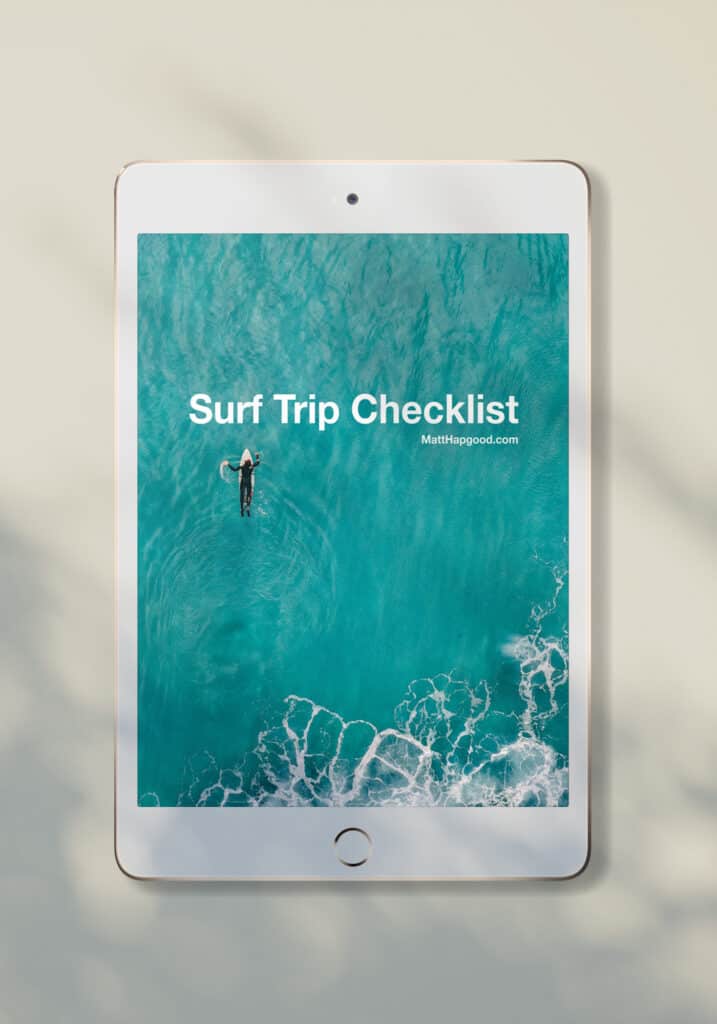Offshore vs Onshore Wind – What Does It Mean For Surfing?
Last Updated on November 23, 2023 by Matt Hapgood
As surfers, we are constantly looking at the weather, the tides, and the swell.
and of course, the wind is an integral part of how waves and swells are formed, but what about the wind at a ‘local’ level – is an offshore wind better than an onshore wind?
All of your questions about onshore and offshore wind will be answered in this blog post. Let’s rip in!
TL;DR (Too long didn’t read)
Offshore winds blow from the land to the ocean, creating smooth, clean waves.
Onshore winds blow from the ocean to the land creating messy, choppy waves.
Defining Onshore and Offshore Wind for Surfing
First up let’s look at what the difference is between an offshore wind and an onshore wind and what gives the best surf conditions. Oftentimes if the wind is blowing hard, paddling your surfboard can be tricky, which is why I prefer surfing when the wind is light.
Onshore Winds

An onshore wind blows from the sea towards the land. As the wind hits the ocean’s surface, it pushes waves up and causes them to peak prematurely. This creates choppy, waves that are difficult to ride.
The lip, or the top part of the breaking wave is more ‘crumbly’ when the wind is onshore.
Offshore Winds

In contrast, an offshore wind travels from the land out to sea. Typically the best winds for surfing are offshore. Strong offshore winds smooth out the wave surface, letting waves build larger and hold their shape longer before breaking.
This results in the fun, crumbling waves that surfers live for. With an offshore wind at your back, you can spot incoming swells easily.
Comparing the Impact on Waves – Offshore vs Onshore
The difference between onshore and offshore winds is night and day. Onshore winds of 10 knots or more spell trouble for surfers.
Offshore winds can produce epic surf even in marginal swell. Light to moderate offshore winds, around 5-15 knots, offer the best wave riding conditions.
Identifying Wind Conditions
Paying attention to weather maps, forecasts, and visual wind indicators like flags and water textures can clue you into onshore or offshore winds.
Knowing the prevailing wind patterns at your local break goes a long way as well.
Using Winds to Your Advantage
The wind direction may dictate whether you score a fun sesh or a closeout-filled washing machine ride. Make like a sailor and use the wind to your advantage to find the best waves. With the right winds, you’ll be off to an epic session in no time.
What is cross-shore wind?
A cross-shore wind blows perpendicular to the shoreline, crossing over the beach and ocean surface. This wind direction can create unstable choppy surf conditions.
Is offshore or onshore wind better for surfing?
Offshore wind is considered much better for surfing compared to onshore wind.
Why Is Offshore Wind Considered The Best For Surfing?
Offshore winds smooth out the ocean surface and help waves barrel
Offshore winds smooth out the ocean surface and help waves build larger over a longer distance. This allows waves to hold their shape better before breaking.
Easier to spot incoming swells
The smooth surface enables surfers to spot incoming swells more easily.
Improves visibility
Offshore winds blow spray away from surfers instead of into their faces like onshore winds. This improves visibility dramatically.
Creates epic peeling waves
Waves break slower and peel longer under offshore winds. This creates the epic peeling waves that surfers dream about riding.
Enhances marginal conditions
Even light offshore winds can improve poor or marginal wave conditions. Onshore winds degrade waves and close them out prematurely.
By blowing from land towards sea, offshore winds enable waves to break later with better shape and surfable faces. That’s why offshore wind is a surfer’s best friend!
Cross Shore Winds
Predicting Onshore and Offshore Winds
Being able to forecast wind conditions is an invaluable skill for surfers. Learning to analyze weather maps, pressure gradients, and numeric wind predictions will help you anticipate upcoming wind shifts from onshore to offshore or vice versa.
Pay close attention to the positions of high and low pressure systems, as winds flow clockwise around high pressure and counter-clockwise around low pressure. Monitor buoys and coastal weather stations for real-time wind speed and direction reports. Feed all this data into your own analysis to become your local surf spot’s wind forecaster.
Finding Wind Protection
When harsh onshore winds arise, hitting the beach with perfectly groomed offshore waves, all hope of a surf session is not lost. Certain spots like coves, points, and bay formations can provide wind protection by blocking onshore gusts.
Headlands and peninsulas can cause winds to split overhead, resulting in a calm zone of offshore winds in their lee. The reduction in wind strength downwind of natural barriers is typically between 15-20% but can reach upwards of 50% in some semi-enclosed bays. When winds whip onshore at 20 knots, seeking out these wind shadows saves the day.
Impacts of Windswells
While local winds directly affect wave quality, distant storm winds transfer their force into rhythmic swells arriving days later. These “windswells” are generated by distant low pressure systems producing extensive wind fields blowing over hundreds of miles of open ocean.
The wind’s duration, strength, and consistency determines the size and quality of swells formed. When these organized bands of wind wave energy show up along the coast, they arrive with their full original offshore wind momentum.
Even if local winds are onshore, these swells maintain their shape and power. Tracking storm systems through weather satellites and buoys is the only way to anticipate windswells since swells can easily travel 500-1000 miles in just a few days after being created.








